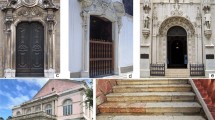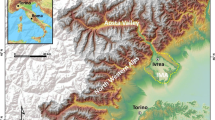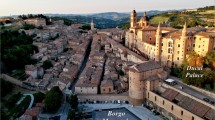Abstract
Natural stones, their origin and usage represent a segment of geoheritage. They not only represent natural value and beauty in their in situ areas but also bring their qualities closer to all of us in the ex situ places, where these stones are used. Knowledge about certain rock types, their age and origin, as well as exploitation methods, can give additional information on their importance and preservation. This knowledge should not be connected only with scientific work or displayed in museums but should be available daily to people of all ages and interests. Croatia is a country rich in sedimentary rocks due to its geological history. Therefore, natural stones represent valuable Croatian geoheritage and Zagreb urban geoheritage. Zagreb, the capital of Croatia, is a city in which strong connection of the building stones used in the city and geology of the area can be seen from the historical usage of local rocks, mainly from the quarries in the area of the nearby Medvednica Mt. Other commonly used natural stones include mostly limestones, which are exploited from quarries in southern parts of Croatia (Istria and Dalmatia), like various types of rudist limestones (Veselje unito, Veselje fiorito, Rasotica), oncolytic and stylolithic limestones and Lithiotis limestones. Magmatic stone varieties are not exploited in Croatia, but their beauty, quality and common usage in modern times contribute to the geoheritage in general. This paper presents an overview of varieties of different natural stones, their usage and contribution to Croatian geoheritage and their potential for the promotion of urban geoheritage and geotourism in the City of Zagreb.







Similar content being viewed by others
References
Anon (2016) Motion 091 – conservation of moveable geological heritage. IUCN World Conservation Congress. Planet at the Crossroads. September 2016, Hawaii
Basso D, Vrsaljko D, Grgasović T (2008) The coralline flora of a Miocene maërl: the Croatian “Litavac”. Geol Croat 61(2–3):333–340
Brocx M, Semeniuk V (2007) Geoheritage and geoconservation – history, definition, scope and scale. J R Soc West Aust 90:53–87
Brocx M, Semeniuk V (2019) Building stones can be of geoheritage significance. Geoheritage 11:133–149
Crnković B, Bilbija N (1984) Vrednovanje arhitektonsko–građevinskog kamena (Evaluation of Dimension Stone – in Croatian). Geol Vjesn 37:81–95
Crnković B, Jovičić D (1993) Dimension stone deposits in Croatia. Rudarsko-geološko-naftni zbornik 5:139–163
Crnković B, Poggi F (1995) Travertine the restoration stone for the Zagreb Cathedral. Rudarsko-geološko-naftni zbornik 7:77–85
Crnković B, Šarić LJ (2003) Građenje prirodnim kamenom (Building with natural stone – in Croatian). Institut Građevinarstva Hrvatske, Zagreb, 380 p
Crnković B, Tadej N, Pollak D (1994) The influence of acid rains on the Lithothamnian limestone on the gallery of the Mary’s Ascension Cathedral, Zagreb, Croatia. Rudarsko-geološko-naftni zbornik 6:1–9
da Silva CM (2017) Urban geodiversity and decorative arts: the curious case of the “Rudist tiles” of Lisbon (Portugal). Geoheritage 11:151–163
Debeljak I, Buser S (1997) Lithiotid bivalves in Slovenia and their mode of life. Geologija 40:11–64
Dickson JAD (1965) A modified technique for carbonates in thin section. Nature 205:497–1587
Dunham RJ (1962) Classification of carbonate rocks according to depositional textures. Am Assoc Pet Geol 1:108–121
Embry AF, Klovan JE (1971) A Late Devonian reef tract on northeastern Banks Island, NWT. Bull Can Petrol Geol 19:730–781
Esbert RM, Marcos RM, Ordaz J, Montoto M, Suarez Del Río LM, Ruiz De Argandoña VG, Calleja L, Alonso FJ, Rodríguez Rey A (1989) Petrografía, propiedades físicas y durabilidad de algunas rocas utilizadas en el patrimonio monumental de Catalunya (España) – in Spanish with English abstract. Mater Constr 39(214):37–47
Fio Firi K (2017) Geološka šetnja Zagrebom – primjer geoturističke ponude (Geological walk through the city of Zagreb – an example of the geotouristical offer – in Croatian). Međunarodni znanstveno-stručni skup: Georaznolikost, geobaština i geoturizam u krškim područjima, Pećinski park Grabovača, Perušić, 18–19.02.2017., Zbornik sažetaka, 9 pp
Fio Firi K, Maričić A (2019) City geoheritage – geological and geoturistical aspect of the natural stone, examples from Zagreb (Croatia). 6th Croatian Geological Congress, Zagreb, 9–12.10.2019., Abstracts Book, 62–63
Flügel E (2010) Microfacies of carbonate rocks: analysis, interpretation and application, 2nd edn. Springer-Verlag, Berlin, pp 7–266
Fort R, Bernabeu A, Garca del Cura MA, Lopez de Azcona MC, Ordonez S, Mingarro F (2002) Novelda Stone: widely used within the Spanish architectural heritage. Mater Constr 52(266):19–32
Fort R, Varas MJ, Alvarez de Buergo M, Martin-Freire D (2011) Determination of anisotropy to enhance the durability of natural stone. J Geophys Eng 8(3):132–144
Freire-Lista DM, Fort R (2019) Historical city centres and traditional building stones as heritage: Barrio de las Letras, Madrid (Spain). Geoheritage 11:71–85
Gušić I, Jelaska V (1990) Stratigrafija gornjokrednih naslaga otoka Brača u okviru geodinamske evolucije Jadranske karbonatne platforme (Upper Cretaceous Stratigraphy of the island of Brač within the Geodynamic Evolution of the Adriatic Carbonate Platform). Djela Jugoslavenske akademije znanosti i umjetnosti 69:160
Habibi T, Ponedelnik AA, Yashalovac NN, Ruban DA (2018) Urban geoheritage complexity: evidence of a unique natural resource from Shiraz city in Iran. Res Policy 59:85–94
HRN EN 12440 (2017) Natural stone – Denomination criteria. European Standard
HRN EN 12670 (2019) Natural stone – terminology. European Standard
Ingham J (2013) Building stone. In: Ingham J (ed) Geomaterials under the microscope, 1st edn. Academic Press, Cambridge, pp 21–50
Ivaninić D (2014) Onkolitni vapnenci Kanfanara (Oncolithic limestones of Kanfanar – in Croatian). Bachelor’s thesis, University of Zagreb. 42 p
Kramar S, Bedjanič M, Mirtič B, Mladenović A, Rožić B, Skaberne D, Gutman M, Zupančić N, Cooper B (2015) Podpeč limestone: a heritage stone from Slovenia. In: Pereira D, Marker B, Kramar S, Cooper B, Schouenborg B (eds) Global heritage stone: towards international recognition of Building and ornamental stones. Geological Society, London, Special Publications, London 407(1):219–231
Krobicki M, Golonka J (2009) Palaeobiogeography of Early Jurassic Lithiotis-type bivalve buildups as recovery effect after Triassic/Jurassic mass extinction and their connections with Asian palaeogeography. Acta Geosci Sin 30(1):30–33
Lygina EA, Fokin PA, Kopaevich LF, Nikishin AM, Yakovishina EV (2016) Nummulitic facies of the Crimean-Caucasian region. Turk J Earth Sci 25:163–178
Marinković V, Miliša M (2015) Marmore Lavdata Brattia. Exhibition catalog Marmore Lavdata Brattia Museum of the City of Split, Split, p 32
Mısırlısoy D, Günçe K (2016) Adaptive reuse strategies for heritage buildings: a holistic approach. Sustain Cities Soc 26:91–98
Moshammer B, Uhlir C, Rohatsch A, Unterwurzacher M (2014) Adnet ‘Marble’, Untersberg ‘Marble’ and Leitha limestone—best examples expressing Austria’s physical cultural heritage. Eng Geol Soc Territ 5:253–257
NN 152/14 (2014) Zakon o izmjenama i dopunama zakona o zaštiti i očuvanju kulturnih dobara (Law on amendments to the law on the protection and preservation of cultural heritage – in Croatian). Croatian Parliament
NN 44/17 (2017) Zakon o izmjenama i dopunama zakona o zaštiti i očuvanju kulturnih dobara (Law on amendments to the law on the protection and preservation of cultural heritage – in Croatian). Croatian Parliament
Pavelić D, Kovačić M (2018) Sedimentology and stratigraphy of the Neogene rift-type North Croatian Basin (Pannonian Basin System, Croatia): a review. Mar Pet Geol 91:455–469
Pentecost A (2005) Travertine. Springer-Verlag, Berlin, 445 p
Přikryl R, Török A (2010) Natural stones for monuments: their availability for restoration and evaluation. In: Přikryl R, Török A (eds) Natural stone resources for historical monuments, vol 333. Geological Society of London, Special Publications, London, pp 1–9
Punturo R, Russo LG, Giudice AL, Mazzoleni P, Pezzino A (2006) Building stone employed in the historical monuments of Eastern Sicily (Italy). An example: the ancient city Centre of Catania. Environ Geol 50:156–169. https://doi.org/10.1007/s00254-006-0195-3
Streckeisen A (1976) To each plutonic rock its proper name. Earth-Sci Rev 12:1–33
Šimunić Buršić M, Aljinović D, Cancelliere S (2007) Kirmenjak-Pietra d’Istria: a preliminary investigation of its use in venetian architectural heritage. In: Prikryl R, Smith BJ (eds) Building stone decay: from diagnosis to conservation, vol 271. Geol Soc Lond, Spec Publ, London, pp 63–68
Tišljar J (1978) Onkolitni i stromatolitni vapnenci u donjokrednim sedimentima Istre (Oncolites and stromatolites in Lower Cretaceous carbonate sediments in Istria Croatia, Yugoslavia – in Croatian). Geol Vjesn 30(2):363–382
Tišljar J, Vlahović I, Matičec D, Velić I (1995) Platformni facijesi od gornjeg titona do gornjega alba u zapadnoj Istri i prijelaz u tempestitne, klinoformne i rudistne biolititne facijese donjega cenomana u južnoj Istri, ekskurzija B (Platform Facies from the Upper Tithonian to Upper Albian in Western Istria and Transition into Tempestite, Clinoform and Rudist Biolithite facies of the Lower Cenomanian in Southern Istria, Excursion B). In: Vlahović I, Velić I (eds) 1st Croatian Geological Congress. Excursion Guide-Book, Zagreb, pp 67–110
Tomašić I, Lukić D, Peček N, Kršinić A (2009) Važnost ispitivanja kapilarne vodoupojnosti prirodnog kamena (Importance of testing capillary water absorption of stone – in Croatian). Klesarstvo i graditeljstvo 3–4:17–27
Tomašić I, Lukić D, Peček N, Kršinić A (2011) Dynamics of capillary water absorption in natural stone. Bull Eng Geol Environ 70(4):673–680
Vadjić V, Hršak J, Jukić JJ (2000) Trends of air quality in Zagreb. IUAPPA Praha 2000:82–86
Velić I, Velić J (1995) Geological Map of Croatia. First Croatian Geological Congress, 18–21 October 1995, Opatija, Croatia. Institute of Geology, Zagreb
Velić I, Matičec D, Vlahović I, Tišljar J (1995) Stratigrafski slijed jurskih i donjokrednih karbonata (bat-gornji alb) u zapadnoj Istri (ekskurzija A) (Stratigraphic succession of Jurassic and Lower Cretaceous Carbonates (Bathonian – Upper Albian) in Western Istria (Excursion A)). In: Vlahović I, Velić I (eds) 1st Croatian Geological Congress. Excursion Guide-Book, Zagreb, pp 31–66
Vrsaljko D, Pavelić D, Bajraktarević Z (2005) Stratigraphy and palaeogeography of Miocene deposits from the marginal area of Žumberak Mt. and the Samoborsko gorje Mts. (northwestern Croatia). Geol Croat 58(2):133–150
Vrsaljko D, Pavelić D, Miknić M, Brkić M, Kovačić M, Hećimović I, Hajek-Tadesse V, Avanić R, Kurtanjek N (2006) Middle Miocene (Upper Badeninan/Sarmatian) palaeoecology and evolution of the environments in the area of Medvednica Mt. (North Croatia). Geol Croat 59(1):51–63
Winkler EM (1994) Stone in architecture properties, durability. Springer, Berlin, p 313
Zebec V (1975) Kalcit i dolomit iz okolice sela Bizek i Dolje kod Podsuseda u Medvednici (Zagrebačka gora) – in Croatian with German abstract. Acta Geol Prirodoslovna istraživanja 41:287–314
Zoghlami K, Martín-Martín JD, Gómez-Gras D, Navarro A, Parcerisa D, Rosell JR (2017) The building stone of the Roman city of Dougga (Tunisia): provenance, petrophysical characterisation and durability. Compt Rendus Geosci 349:402–411
Acknowledgements
Authors are grateful to Šimun Aščić for photographs, Renata Brezinščak for enthusiastic support of this idea and Katarina Gobo for useful comments. We are grateful to our mentors Jasenka Sremac and Ivan Tomašić for their support. We are thankful to our Faculties for providing analytical support. During the time of review of this manuscript, the City of Zagreb was, on 22nd March 2020, struck by an earthquake with M 5.5, which caused significant damage. Many buildings presented in this paper, including Zagreb Cathedral, were badly damaged, and we hope that information on used natural stones will be of interest for their renovation. The authors would like to thank two anonymous reviewers and editor of Geoheritage for constructive and helpful comments on the manuscript.
Funding
We would like to thank Croatian Geological Society and SX Hrvatska for financing the making of the web page: http://geoloskasetnjazagreb.com/ (accessed 18th November 2019) connected to this work.
Author information
Authors and Affiliations
Corresponding author
Rights and permissions
About this article
Cite this article
Fio Firi, K., Maričić, A. Usage of the Natural Stones in the City of Zagreb (Croatia) and Its Geotouristical Aspect. Geoheritage 12, 62 (2020). https://doi.org/10.1007/s12371-020-00488-x
Received:
Accepted:
Published:
DOI: https://doi.org/10.1007/s12371-020-00488-x




